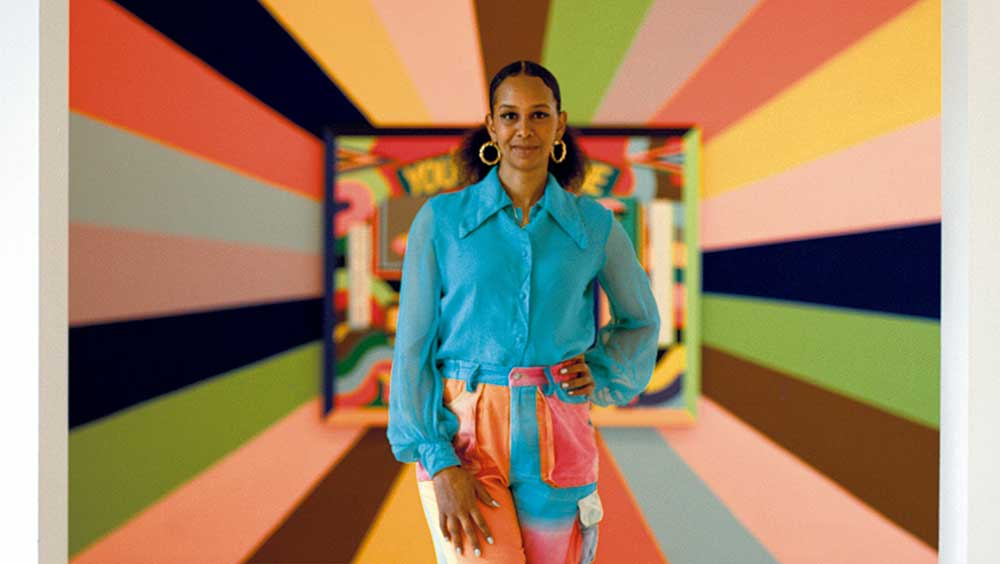
Lakwena Maciver, Hastings Contemporary, 2021. Photo: Sam Butt.
by DAVID TRIGG
Words have always fascinated Lakwena Maciver (b1986, London), and her kaleidoscopic murals, paintings and installations centre on short, evocative phrases, often hinting at deeper and sometimes spiritually profound meanings. Her dazzling works in the public realm bring colour, pattern and positivity to drab urban spaces, challenging and subverting the messages of commercial advertising. Her panel paintings and gallery installations are similarly imbued with a relentless optimism and hope. Family heritage, black history, faith, music, fashion and sport are among the manifold influences that inform these works, which are rooted in her formative experiences growing up in London and East Africa.
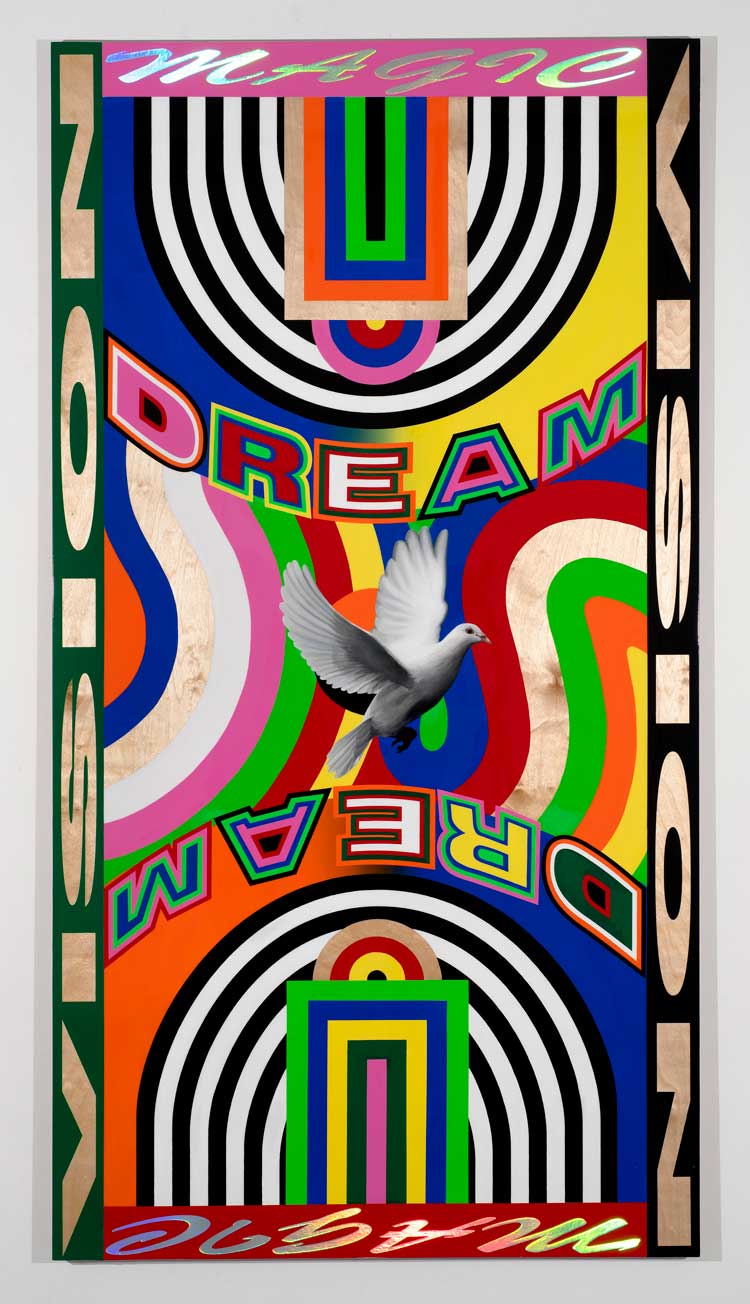
Lakwena Maciver. Larry, 2021. Acrylic and polyurethane on plywood, 206 x 110 cm (81 1/8 x 43 1/4 in).
Born to an English mother and Ugandan father, Maciver was initially raised in Enfield before moving to Ethiopia for several years. Back in the UK, her love of words and travel led her to apply to study modern languages at King’s College London, but an invitation to paint a mural for a church in Brazil changed the course of her life. Switching to graphic design, she graduated from the London College of Communication in 2009. With her 2013 mural, I Remember Paradise, finding a large and appreciative audience at the Wynwood Walls street art festival in Miami, it was not long before her work gained international recognition.
,-2020-Pine-Bluff,-Arkansas.-photo-copyright-JustKids.jpg)
Lakwena Maciver, I'll Bring You Flowers (detail), 2020. Pine Bluff, Arkansas. Photo copyright JustKids.
Since then, her work has been exhibited widely, from installations at Tate Britain, Somerset House and the Southbank Centre in London, to a juvenile detention centre and basketball courts in Arkansas, a monastery in Vienna, and the Bowery Wall in New York City. More recently, she has brought to life the little-known half-acre roof terrace on top of Temple underground station in London and embarked on her new series of colourful and highly patterned Jump Paintings – abstract portraits of some of the most inspiring American basketball players of recent times, including Michael Jordan, Shaquille O’Neal, Dennis Rodman and Larry Bird. As with all her works, positive and life-affirming words are a key ingredient.
In this interview for Studio International, the London-based artist discusses her distinctive aesthetic and interest in words, the significance of spirituality to her art, her recent large-scale commissions and her new exhibition of Jump Paintings at Vigo Gallery, London.
David Trigg: You are best known for your large-scale murals painted in the public realm. What attracts you to this way of working?
Lakwena Maciver: My work is very much about wanting a space to speak and having my voice heard, which murals allow me to do on a large scale. I’m interested in the things that people interact with in their everyday lives, like music and fashion – things that you don’t have to go into a special space like a gallery to see. I like that murals are usually very accessible and there’s no exclusivity. When I was studying graphic design, I looked at Diego Rivera’s murals and I was drawn to his democratic, anti-elitist approach – the idea of murals being for the people. I also became interested in early graffiti and street art – another way for people’s stories to be told through art outside a traditional gallery space.
,-2020,-photo-copyright-JustKids.jpg)
Lakwena Maciver, I'll Bring You Flowers (detail), 2020. Pine Bluff, Arkansas. Photo copyright JustKids.
DT: Your instantly recognisable imagery is defined by bold geometric patterns and bright colours. How did you arrive at this distinctive visual language?
LM: Sign-writing and all those types of things interest me, but at the beginning I was thinking about African street signs that I’d seen when I was growing up, which were very clearly handmade and immediate – they evoked a sense of agency because the people who made them were saying exactly what they wanted to say. Patterns have also always interested me. I like maths and repetition, which ties in with music as well. Musicality is part of my heritage: I grew up surrounded by singing, and those rhythms and patterns are something that come into my work. But, for me, it’s mostly about the words. I’ve always loved words and have been attracted to them since I was a child, what they mean, but also how they look. The first time I painted words on a large scale was for my mum, who led small protest marches throughout my childhood. I used to make signs with her and then we would walk through Trafalgar Square carrying them, which felt really powerful. I like the idea that you can put anything on a sign.
DT: What about your colour choices?
LM: In East Africa there was a lot more colour: the way people dressed and the way they decorated their homes. But it was also the sunlight, which just changes the way everything looks. Here, in England, you get a lot of grey sky, whereas in African countries the blue sky dominates your field of vision. It’s all greyer here, even the streets. Much of my work has been about trying to recreate my childhood memories of East Africa and what felt like a very happy time for me; it felt like paradise. So, it’s partly about evoking some of those memories, but colour tends to make people feel joyful and a lot of my work is about trying to imbue the grey realities of life with joy and hope.
DT: Your works also bring to mind various artists who have worked with text, such as Barbara Kruger, Lawrence Weiner and Mark Titchner. Do you have any affinity with these artists?
LM: I feel more of an affinity with someone like Emory Douglas, the minister of culture for the Black Panther party. His work is really powerful, mixing words, collage, hand-drawn outlines and iconography that resonated with people to get his message across. It feels quite raw and that’s what I aspire to.
DT: Text is an important element of your work, though. Whereas your graphic style is very direct and punchy, the statements you incorporate into your compositions can be quite nuanced and open to interpretation.
LM: That ambiguity is intentional. I’m interested in different layers of meaning – that I can say one thing and it can be received in different ways and mean different things to different people. The words are definitely more subtle; the colours and patterns attract the eye, but the words whisper.
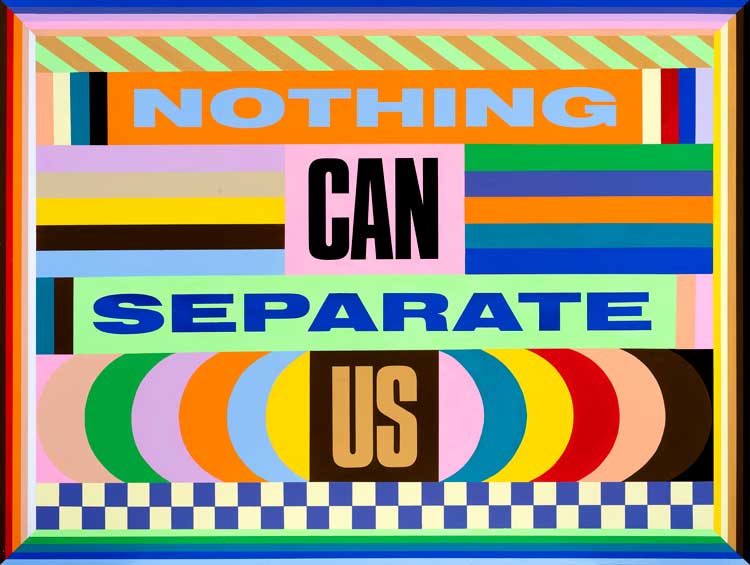
Lakwena Maciver, Nothing Can Separate Us, 2020. Acrylic on wood panel, 91x 121 cm. © The Artist. Photo courtesy Vigo Gallery.
DT: What attracts you to particular words and phrases?
LM: It’s just whatever resonates with me. A lot of the time, the work that I’m making relates to something I’m going through, or where I’m at in life. With a painting like Nothing Can Separate Us (2020), which took a long time to finish because I had my baby, I wanted to make that declaration because it spoke truth and hope into my situation at the time. I tend to be a pessimist naturally, which you wouldn’t know from my work, which is actually trying to counter that. I made the original painting for my home just before the first Covid lockdown. The phrase, which comes from the Book of Romans, appealed to me as I was thinking about connections between people and not wanting to be separated from others, but also about a deeper, more solid connection with a higher power that holds everything together and transcends space and time.
DT: Do you collect texts, writing them down as you come across them?
LM: Yes, I do write down texts, but I’m not very organised. I have loads of random scraps of paper stuck to my studio wall.
DT: You have likened your works to prayers and meditations.
LM: That’s what I see many of them as. I pray as part of my process and meditate on words. In a way, the works are a way of making that more solid and permanent. Some are almost like a visual representation of a song and I’ll often reference song lyrics.
DT: For you, prayer is a spiritual practice. How does spirituality inform your art?
LM: At its heart, my work is about a longing for paradise. As a child, I was always drawing, but when I was about 10, just after I’d returned to England from Ethiopia, I remember drawing a lot of aeroplanes and houses, over and over. Looking back, I think I was trying to process this massive life change. Pretty soon after my return, I began to encounter racism, and art became a way of coping with that; not resolving the issue but trying to make sense of it and fighting back by making strong and powerful images. Art was my way of processing, of surviving and healing. As I mentioned, my time in Ethiopia was very happy and it felt like a kind of paradise, but I’ve now come to realise that paradise isn’t in East Africa, it is in Heaven. Much of my work has been about trying to evoke this place where I felt I belonged, where I felt loved and connected, which for me is very much what Heaven is about.
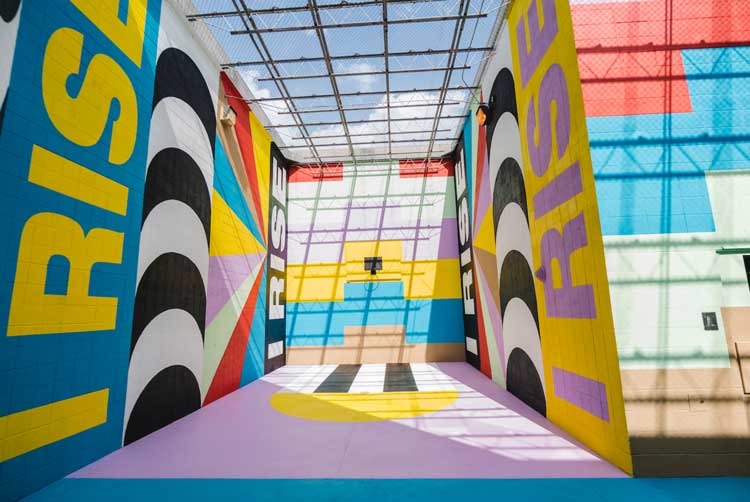
Lakwena Maciver, Still I rise, Sebastian County Juvenile Detention Centre, Arkansas, 2017. Courtesy Vigo Gallery.
DT: In 2017 your mural Still I Rise transformed a dreary recreation yard at the Sebastian County juvenile detention centre in Arkansas. How did this project come about?
LM: The curator Charlotte Dutoit, whom I’d worked with before, invited me to do that as part of an arts festival called The Unexpected. There were a number of artists doing different projects and this was the one they felt would best suit me. I want my work to be seen and connect with people in all sectors of society, so it was an honour to make work in that context. The idea of painting in a juvenile detention centre really moved me because I’d started making work when I felt marginalised as a teenager and didn’t feel that my voice was being heard. Those prisoners are literally marginalised, locked up and, for some, with no hope of getting out.
DT: The mural references Maya Angelou’s famous poem Still I Rise (1978). What prompted you to incorporate her words?
LM: Maya Angelou was from Arkansas. She had a really difficult childhood and there was a lot of adversity in her life, which is where her poetry came from. I thought Still I Rise might inspire some hope in the kids, some of whom had never heard it before; that poem can’t fail to inspire, it’s incredible.
DT: What was it like working with the inmates who helped you create the piece?
LM: There were a load of volunteers from outside of the centre, but then there were about 10 inmates, who were brilliant. They were really good because they had loads of energy and a great attitude – very sweet kids. It was really nice to work with them.
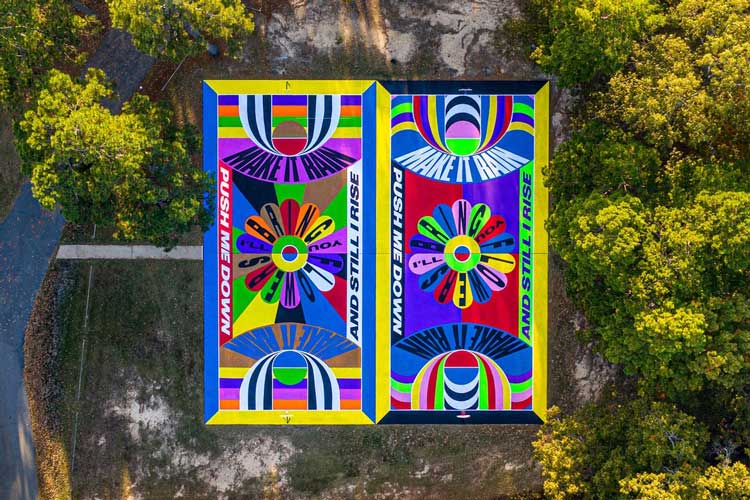
Lakwena Maciver, I'll Bring You Flowers, 2020. Pine Bluff, Arkansas. Photo copyright JustKids.
DT: You also incorporated Angelou’s words into I’ll Bring you Flowers (2020), the two full-size basketball courts that you painted in Pine Bluff, Arkansas.
LM: I referenced the poem again because I wanted to connect the two works. But I’ll Bring You Flowers was inspired by a viral video of Senator Flowers of Arkansas, an African-American woman who was ranting about how ridiculous the “stand-your-ground” law was. She was upset because some members of the state’s judiciary committee tried to limit debate time on the issue. I was really inspired by her. That’s why I titled the work I’ll Bring You Flowers – I wanted to shout out Senator Flowers and honour the black community there because it’s a predominantly African American neighbourhood. It was in the midst of the Black Lives Matter uprising, too, so it was a way for me to pay my respects, which is what you often do with flowers.
DT: How did you devise the compositions?
LM: When I was a teenager, my brother had a lot of basketball magazines that I used to look at. I was very inspired by the 1990s hip-hop aesthetic: the typography, the colours, the textures and how basketballers dressed. The way that blackness was being evoked through graphics was really powerful and beautiful and resonated with me. The compositions for Arkansas were quite instinctive; I didn’t have a particular plan, I was just having fun. The court markings were definitely a framework to guide me though, and fitted well with my appreciation for geometric forms. I liked the idea of including the flower motifs because flowers tend to be associated with femininity and basketball tends to be associated with masculinity, so I liked that unexpected juxtaposition.
.-Temple-Underground-Roof-Terrace,-London.jpg)
Lakwena Maciver, Back in the Air, A Meditation on Higher Ground, 2021. Temple Underground Roof Terrace, London. Photo copyright David Parry, courtesy Vigo Gallery.
DT: In 2021, you created the kaleidoscopic Back in the Air: A Meditation on Higher Ground for the half-acre roof terrace on top of Temple Underground Station in London. How did you approach this monumental commission?
LM: The difficulty wasn’t so much the scale of it, but practical obstacles, such as the fact that it had to be temporary. I couldn’t screw anything into the surface or paint it. It was Claire Mander, director and curator of theCoLAB, who came up with the idea of using interlocking sports tiles like a mosaic.
DT: So none of it is painted?
LM: The tiles that cover most of the space aren’t, but there is a painting on there as well – a massive version of Nothing Can Separate Us, which is painted on plywood.
DT: Did you use a computer to work out the mosaic design?
LM: Yes. First, I made drawings and then used some cross-stitch software because I needed to break the drawings down into squares. It took a bit of going backwards and forwards and working it out until the squares were the right size in proportion to the surface area of the roof, but it worked out in the end. I like the idea of the piece being stitched together, it was an interesting concept, like the knitting together of things, which ties in with the phrase “nothing can separate us”.
DT: Unusually for you, the mural contains a sculptural element, a small shed-like hut.
LM: There was a practical need for a space to escape from the cold while we were installing the work, but Claire’s idea was that this rooftop is an artist’s garden, which was a helpful prompt for me. The idea of a garden ties in with the theme of paradise that I’m interested in, so to have a hut in the garden seemed appropriate. It’s modelled on the Cabmen’s Shelter on the pavement nearby, a Victorian hut for cab drivers, but it can be seen as a shelter, or home.
DT: These large-scale projects in the public realm have all transformed bleak urban spaces into sites bursting with colour, pattern and messages of hope. Do you consider your work to have a redemptive aspect?
LM: Yes, I think it does. “Bringing colour and joy to the city” is the sort of phrase I hear a lot, but it sounds like a cliche. Redemption is a much better way of thinking about what I’m doing. I like to think my work will bring hope to people, but I don’t presume that people will respond in a particular way.
DT: For your current exhibition at Vigo Gallery, you are showing your recent Jump Paintings series – abstract portraits of American basketball players past and present. What prompted the series?
LM: They are a development of the paintings I did in Arkansas. Basketball resonates with a lot of people around the world who engage with the game and the culture associated with it. Not everyone is into basketball though, but everyone understands what it means to jump – to jump for joy. That’s why I call them Jump Paintings, they are a metaphor for ideas about freedom, agency, black male joy, ambition and self-expression. I think of the basketball court as being like a stage, a space for self-expression. Again, I was using the layout of court as as guide and just playing around with colours, patterns and typography inspired by the players’ kits or the places they are from.
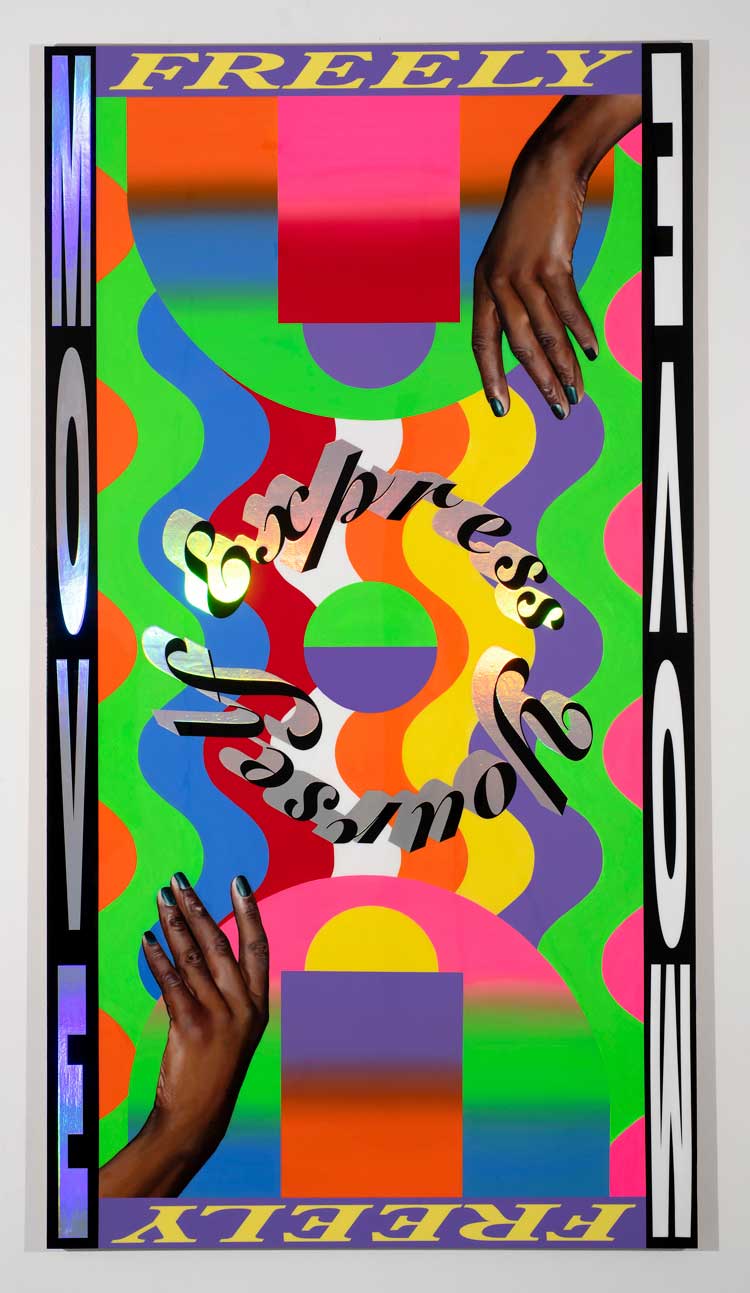
Lakwena Maciver. Dennis, 2021. Acrylic and polyurethane on plywood, 201 x 107 cm (79 1/8 x 42 1/8 in).
DT: And the words in the paintings relate to the players?
LM: Yes, and they also relate to the different themes of my work: joy, hope and the notion of escapism. Basketball can be seen as a celebration of black joy, particularly black male joy and self-expression. Players such as Allen Iverson and Dennis Rodman are a great example of this – their paintings have the words “Express Yourself” on them. Rodman was known for being very expressive, pushing the boundaries of how he adorned and represented himself.
DT: You have said that basketball is indisputably dominated by African Americans, though your portraits include figures such as Larry Bird and Yao Ming, alongside Shaquille O’Neal, Michael Jordan and Rodman. What informed your selection of players?
LM: They are all just great players. A lot of them are from the 1990s, which was an iconic time for basketball. About 90% of them are black men, but it’s not just about blackness, which is a significant theme, it’s also about greatness.
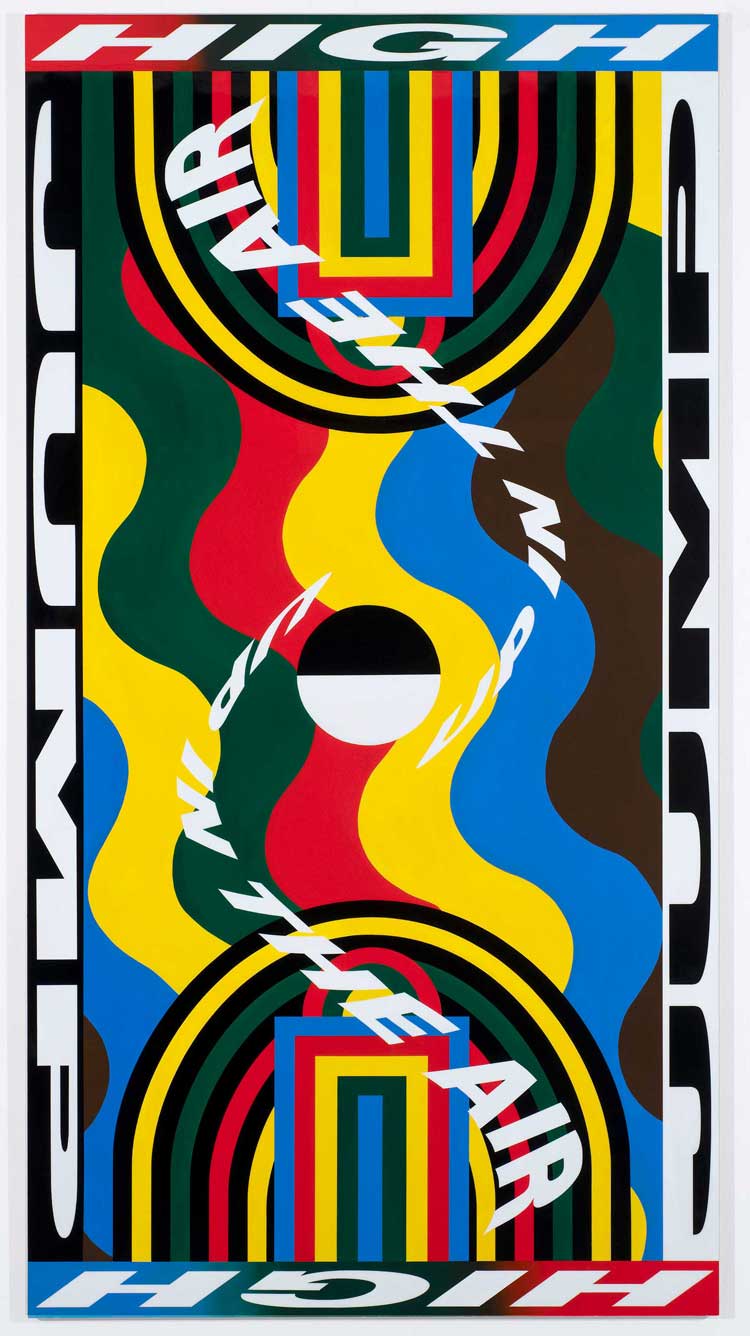
Lakwena Maciver. Michael, 2021. Acrylic and polyurethane on plywood, 198 x 105 cm (78 x 41 3/8 in).
DT: You have said that much of your work has to do with hope. In what way?
LM: Life is really difficult at times, and it can often feel hopeless. My work began at a very difficult time in my life, it began in a very hopeless place. When you’re down in the depths, you really need hope, don’t you? So that’s what my work is about, even if it is a bit of a cliche. For me, it’s about the words, about what’s being said. It’s an incredible privilege to be allowed to paint the walls in my city, a city in which I used to feel marginalised. It feels like I’ve got a place and a voice. My hope is that, through speaking truth into my personal situation, my work might also resonate with others.
• Lakwena Maciver: Jump Paintings is at Vigo Gallery, London, until 28 February 2022.